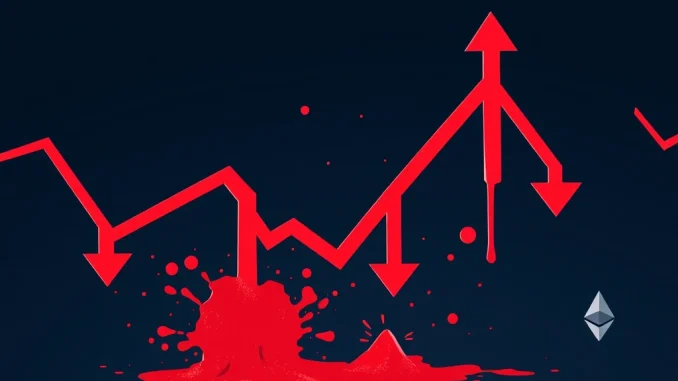
In the fast-paced world of cryptocurrency trading, volatility is a constant companion. One key metric that highlights this volatility and market sentiment is crypto liquidation. When traders use leverage on platforms offering perpetual futures, significant price movements can trigger forced closure of their positions, leading to liquidations. This often results in substantial losses for those on the wrong side of the move.
Understanding Perpetual Futures and Crypto Liquidation
Before diving into the numbers, let’s quickly cover the basics. Perpetual futures contracts are a type of derivative that allows traders to speculate on the price of an asset without owning it. Unlike traditional futures, they have no expiry date. They use a mechanism called the ‘funding rate’ to keep the contract price close to the spot price. Traders use leverage, meaning they can control a large position with a relatively small amount of capital.
Crypto liquidation occurs when a trader’s margin balance falls below the minimum required level to maintain their leveraged position. This typically happens when the market moves against their trade. For instance, if a trader opens a ‘long’ position (betting on the price going up) with high leverage, and the price drops significantly, their position will be automatically closed (liquidated) by the exchange to prevent their balance from going negative. The higher the leverage, the smaller the price movement needed to trigger liquidation.
Monitoring liquidation data provides valuable insight into market sentiment and areas of potential support or resistance where large numbers of leveraged positions are clustered.
The Latest 24-Hour Crypto Liquidation Data
Looking at the past 24 hours, we saw significant activity across major cryptocurrencies. Here’s a breakdown of the perpetual futures liquidations:
- ETH: $87.99 million liquidated
- BTC: $27.49 million liquidated
- SOL: $12.36 million liquidated
The total value of liquidations across these three assets alone exceeded $120 million, indicating a period of notable price movement that caught many leveraged traders off guard.
Breaking Down BTC Liquidation and ETH Liquidation
Analyzing the data further reveals key trends. Ethereum (ETH) perpetual futures traders experienced the highest volume of liquidations, totaling nearly $88 million. This significantly surpassed Bitcoin (BTC) liquidation, which stood at around $27.5 million.
A crucial piece of information is the direction of these liquidated positions:
- ETH Liquidation: 71.79% were Long positions
- BTC Liquidation: 67.04% were Long positions
The high percentage of long liquidations for both ETH and BTC indicates that the dominant price action over the last 24 hours was downward. Traders who were leveraged long, expecting prices to rise or stay stable, were forced out of their positions as prices declined. The larger liquidation volume for ETH suggests it experienced a more pronounced or rapid downward move relative to where leveraged long positions were clustered, compared to BTC.
What the SOL Liquidation Figures Tell Us
Solana (SOL) also saw a substantial amount of liquidations, reaching $12.36 million. Similar to ETH and BTC, the vast majority of SOL liquidation volume came from long positions, accounting for 79.39%.
This extremely high percentage of long liquidations for SOL indicates a strong downward price impulse that heavily impacted traders betting on continued upward movement or stability. It suggests that SOL might have experienced a sharper percentage drop or had a larger concentration of vulnerable leveraged long positions compared to BTC and ETH, relative to its market cap.
Actionable Insights from Perpetual Futures Activity
What can traders take away from this snapshot of perpetual futures activity?
- Volatility is Real: Over $120 million in liquidations in 24 hours is a stark reminder of the risks associated with leveraged trading in crypto.
- Market Sentiment: The dominance of long liquidations points to recent bearish price action across these major assets. It indicates that short-term momentum was to the downside.
- Risk Management is Paramount: This data underscores the importance of setting stop-losses and managing leverage carefully. Being liquidated means your entire margin for that position is gone.
- Areas of Interest: High liquidation areas can sometimes act as future price points where significant market interaction might occur again.
For anyone involved in or considering trading perpetual futures, understanding these dynamics is essential. While leverage can amplify gains, it equally amplifies losses, leading to events like the significant crypto liquidation volume seen recently.
Summary: Navigating the Waves of Crypto Liquidation
The last 24 hours delivered a sharp lesson in the realities of leveraged trading, with over $120 million in perpetual futures positions liquidated across ETH, BTC, and SOL. The overwhelming majority of these were long positions, clearly indicating that recent price action was unfavorable to bullish leveraged bets. Ethereum saw the largest liquidation volume, followed by Bitcoin and Solana, with SOL showing the highest percentage of long liquidations. This data serves as a powerful indicator of market volatility and reinforces the critical need for robust risk management strategies when engaging with leveraged trading products. Stay informed and trade cautiously.



